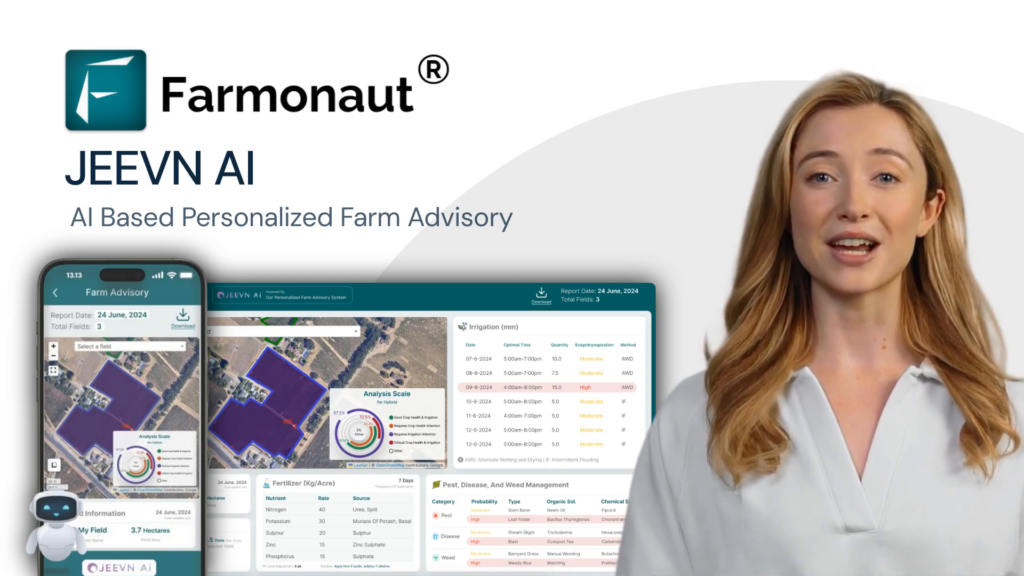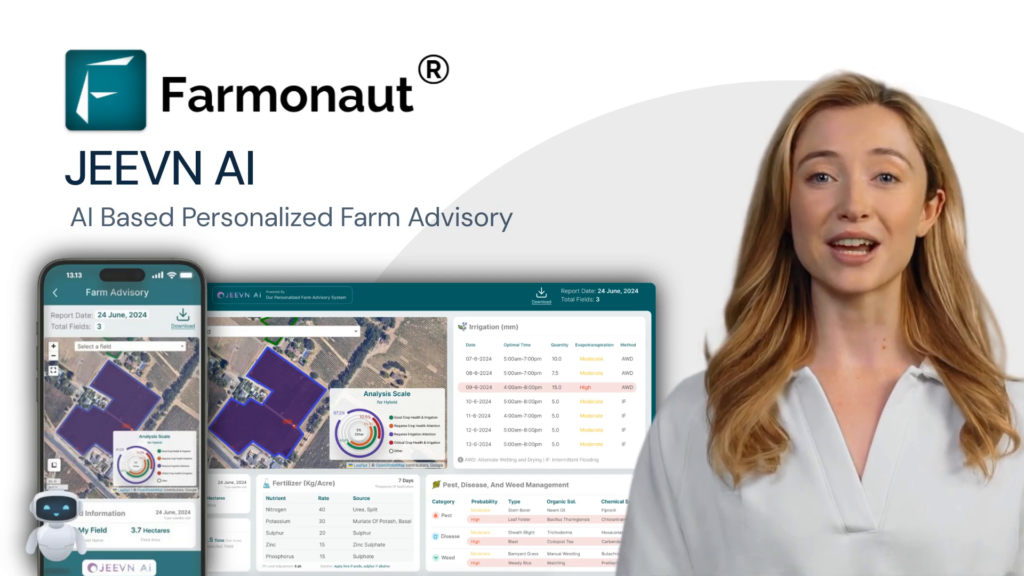50 Years of Innovation: How Round Baler Technology Revolutionized Hay Production in Pennsylvania
“Round baler technology has evolved over 50 years, transforming from chain-based systems to modern belt-driven models with air bag density control.”
In the heart of Pennsylvania’s agricultural landscape, a quiet revolution has been unfolding over the past five decades. The humble round baler, once a novel piece of farm equipment, has transformed into a sophisticated machine that has redefined hay production and farming efficiency. As we celebrate 50 years of innovation in round baler technology, we at Farmonaut are excited to take you on a journey through time, exploring how these remarkable machines have shaped the agricultural heritage of the Keystone State.
From the rolling hills of Lancaster County to the vast farmlands of Ephrata, PA, round balers have become an indispensable part of the farming arsenal. These machines have not only increased productivity but have also played a crucial role in optimizing livestock feed and promoting sustainable farming practices. Let’s delve into the fascinating world of round baler technology and discover how it has revolutionized hay production in Pennsylvania and beyond.
The Birth of Round Baler Technology
The story of round balers begins in the early 1970s when agricultural machinery advancements were gaining momentum. Before this era, farmers relied on labor-intensive methods to gather and store hay, often using small square balers or manual stacking. The introduction of the first commercial round balers marked a significant milestone in farming history.
- 1972: The first viable round baler models hit the market
- 1973: Farmers in Pennsylvania begin adopting this new technology
- 1975: Round balers start to gain popularity across the US
These early models were revolutionary, but they were just the beginning of a long journey of innovation and improvement.

The Evolution of Baling Systems: From Chains to Belts
One of the most significant advancements in round baler technology was the transition from chain-based systems to belt-driven models. This shift marked a new era in hay production efficiency.
- Chain-based systems (1970s-1980s):
- Robust and durable
- Prone to wear and tear
- Higher maintenance requirements
- Belt-driven systems (1980s-present):
- Improved bale formation
- Reduced crop loss
- Enhanced overall efficiency
The shift to belt-driven systems was a game-changer for Pennsylvania farmers, especially those in the dairy and livestock sectors. The new technology allowed for gentler handling of delicate crops, resulting in higher quality hay and silage.
Precision Agriculture Innovations in Round Balers
As we entered the digital age, round baler technology embraced precision agriculture innovations. These advancements have transformed how farmers approach hay production, allowing for unprecedented levels of control and efficiency.
- Integrated moisture sensors
- GPS-guided baling for optimal field coverage
- Automated density control systems
- Real-time yield monitoring
These features have empowered Pennsylvania farmers to make data-driven decisions, optimizing their hay production processes like never before. At Farmonaut, we understand the importance of precision in agriculture, which is why our satellite-based farm management solutions complement these baler innovations perfectly.
Explore our advanced agricultural technology solutions:
The Introduction of Silage Baler Features
The 1990s saw another significant leap in round baler technology with the introduction of silage baler features. This innovation expanded the versatility of round balers, allowing farmers to produce high-quality feed for livestock year-round.
- Chopping mechanisms for finer cut silage
- Improved sealing for better fermentation
- Enhanced durability to handle wet crops
These advancements were particularly beneficial for Pennsylvania’s thriving dairy industry, ensuring a consistent supply of nutritious feed regardless of weather conditions.
Milestone Advancements: Air Bag Technology and Net Wrapping
“The introduction of net wrapping capabilities in round balers has significantly improved bale preservation and handling efficiency in hay production.”
As we entered the 21st century, round baler technology continued to evolve with two groundbreaking innovations: air bag technology for density control and net wrapping capabilities.
Air Bag Technology
Air bag technology revolutionized bale density control, allowing for:
- Consistent bale density throughout the bale
- Adjustable pressure for different crop types
- Improved bale shape and stability
Net Wrapping Systems
Net wrapping brought several advantages over traditional twine:
- Faster bale wrapping process
- Better weather resistance for outdoor storage
- Reduced crop loss during handling
These advancements have been particularly beneficial for farmers in areas like Lancaster and Ephrata, PA, where efficient hay storage and transportation are crucial for successful farm operations.
Catering to Diverse Farming Operations
One of the most remarkable aspects of round baler technology is its adaptability to various farming scales and types. From small family farms to large commercial operations, round balers have found their place in Pennsylvania’s diverse agricultural landscape.
- Small-scale farms: Compact models with simplified controls
- Mid-size operations: Versatile balers with multiple crop capabilities
- Large commercial farms: High-capacity models with advanced automation
This versatility has allowed round balers to become an integral part of various agricultural sectors in Pennsylvania, including:
- Dairy farming
- Beef cattle operations
- Horse farms
- Crop production
- Emerging markets like hemp farming
At Farmonaut, we recognize the importance of tailored solutions for different farm sizes and types. Our satellite-based crop health monitoring and AI advisory systems are designed to complement modern farming equipment like round balers, enhancing overall farm productivity.
Learn more about our API for developers:
Farmonaut Satellite API
API Developer Documentation

The Impact on Livestock Feed Optimization
Round baler technology has played a crucial role in optimizing livestock feed production, a critical aspect of Pennsylvania’s agricultural economy. The advancements in baling technology have led to:
- Improved feed quality through better preservation
- Reduced nutrient loss during storage
- Greater flexibility in feed management
These improvements have had a significant impact on the state’s dairy and livestock industries, contributing to higher milk yields and better animal health.
Sustainable Farming Practices and Round Balers
As sustainability becomes increasingly important in agriculture, round baler technology has adapted to support more environmentally friendly farming practices. Modern round balers contribute to sustainable agriculture in several ways:
- Reduced fuel consumption through efficient operation
- Minimized soil compaction with larger bale sizes
- Decreased crop waste during harvesting and storage
- Support for no-till and conservation farming methods
These sustainable practices align well with Pennsylvania’s commitment to preserving its rich agricultural heritage while embracing modern, eco-friendly farming techniques.
The Future of Round Baler Technology
As we look to the future, round baler technology continues to evolve, promising even greater efficiency and productivity for Pennsylvania farmers. Some emerging trends include:
- Autonomous baling systems
- Integration with farm management software
- Advanced sensor technology for real-time crop analysis
- Biodegradable wrapping materials
These innovations are set to further revolutionize hay production, making farming more efficient, sustainable, and profitable.
Timeline of Round Baler Innovations in Pennsylvania (1970-2020)
| Year | Innovation | Impact on Hay Production | Estimated Efficiency Gain |
|---|---|---|---|
| 1972 | Introduction of first commercial round balers | Reduced labor requirements, increased baling speed | 30% increase in productivity |
| 1980 | Transition from chains to belts | Improved bale formation, reduced crop loss | 15% improvement in bale quality |
| 1990 | Development of net wrapping systems | Better bale preservation, faster wrapping process | 25% reduction in wrapping time |
| 2000 | Integration of air bag technology for density control | Consistent bale density, improved shape | 20% increase in bale density |
| 2010 | Implementation of precision agriculture features | Optimized field coverage, data-driven decision making | 10% increase in overall efficiency |
| 2020 | Introduction of autonomous baling systems | Reduced labor needs, 24/7 operation capability | 40% increase in operational hours |
The Role of Farmonaut in Modern Agriculture
As round baler technology continues to advance, complementary technologies like those offered by Farmonaut play an increasingly important role in modern agriculture. Our satellite-based farm management solutions provide valuable insights that can enhance the efficiency of baling operations:
- Real-time crop health monitoring to determine optimal baling times
- AI-based advisory systems for improved crop management
- Resource management tools to optimize equipment usage
By integrating Farmonaut’s technology with advanced baling equipment, Pennsylvania farmers can take their hay production to new heights of efficiency and sustainability.
Conclusion: A Legacy of Innovation
As we celebrate 50 years of round baler technology, it’s clear that these machines have left an indelible mark on Pennsylvania’s agricultural landscape. From the early chain-driven models to today’s high-tech, belt-driven systems, round balers have consistently pushed the boundaries of what’s possible in hay production.
The journey of round baler technology is a testament to the innovative spirit of the agricultural community. It reflects a constant drive to improve efficiency, sustainability, and productivity in farming. As we look to the future, we can expect round balers to continue evolving, integrating with other advanced technologies to meet the challenges of 21st-century agriculture.
For Pennsylvania farmers, the round baler revolution has meant more than just improved hay production. It has enabled them to optimize their operations, produce higher quality feed for livestock, and contribute to more sustainable farming practices. As we move forward, the synergy between advanced farm equipment like round balers and cutting-edge agricultural technology solutions like those offered by Farmonaut will undoubtedly shape the future of farming in the Keystone State and beyond.
Here at Farmonaut, we’re excited to be part of this ongoing revolution in agriculture. By providing farmers with powerful, data-driven insights, we aim to complement the advancements in farm machinery, helping to create a more efficient, productive, and sustainable agricultural sector.
As we reflect on 50 years of round baler innovation, we look forward to the next half-century of advancements in agricultural technology. The future of farming in Pennsylvania looks brighter than ever, thanks to the remarkable journey of the round baler and the continuing evolution of agtech solutions.
FAQs about Round Baler Technology
- Q: How has round baler technology improved hay quality?
A: Round baler technology has improved hay quality through better bale formation, reduced crop loss, and enhanced preservation methods like net wrapping. These advancements result in denser bales with better weather resistance, maintaining nutrient content for longer periods. - Q: What are the advantages of belt-driven balers over chain-driven models?
A: Belt-driven balers offer gentler crop handling, reduced maintenance requirements, and improved bale formation. They also tend to be quieter and more fuel-efficient compared to chain-driven models. - Q: How do precision agriculture features in round balers benefit farmers?
A: Precision agriculture features in round balers, such as GPS guidance, moisture sensors, and yield monitoring, allow farmers to optimize their baling operations. These features help in making data-driven decisions, improving efficiency, and ensuring consistent bale quality across fields. - Q: Can round balers be used for crops other than hay?
A: Yes, modern round balers are versatile and can handle various crops including straw, silage, and even specialty crops like hemp. Many models offer adjustable settings to accommodate different crop types and moisture levels. - Q: How do round balers contribute to sustainable farming practices?
A: Round balers contribute to sustainable farming by reducing fuel consumption, minimizing soil compaction, and decreasing crop waste. They also support conservation farming methods and can be integrated with other sustainable agricultural practices.
















